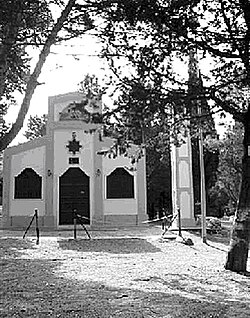Montursi
| Montursi | |
|---|---|
| Frazione | |

Chapel of Saint Joseph the Worker
|
|
| Location of Montursi in Italy | |
| Coordinates: 40°44′0″N 16°50′50″E / 40.73333°N 16.84722°ECoordinates: 40°44′0″N 16°50′50″E / 40.73333°N 16.84722°E | |
| Country |
|
| Region |
|
| Province | Bari (BA) |
| Comune | Gioia del Colle |
| Elevation | 417 m (1,368 ft) |
| Population (2007) | |
| • Total | 700 |
| Demonym(s) | |
| Time zone | CET (UTC+1) |
| • Summer (DST) | CEST (UTC+2) |
| Postal code | 70023 |
| Dialing code | 080 |
| Patron saint | Saint Joseph the Worker |
| Saint day | 1 May |
Montursi (Mendurse in Bari dialect, or Murgia, as the whole region is commonly called) is a frazione or section of the comune of Gioia del Colle, in the Province of Bari, Apulia, southern Italy. It has approximately 700 inhabitants.
The neighbouring settlements are Castellaneta, Laterza, Mottola (all in the Province of Taranto), Matera (in the Province of Matera) and Santeramo in Colle (in Bari).
Montursi is located on the provincial highway between Goia del Colle and Laterza, on the slopes of the Murgia plateau, in an area of steep slopes characterised by the presence of numerous hardwood trees (European oak, Macedonian oak, downy oak) and pine woods; the chapel of Saint Joseph the Worker at Montursi is located in these woods. Since 1959 his festival has been celebrated there on 1 May.
In recent years the pine woods have been improved by the addition of a picnic area, a sports park and an exercise course. Also in the pine woods are buildings that formerly served as the local elementary school and post office, which are today used as places of assembly during the traditional festivities. There is also still an artesian well, used as a water source by farmers.
At an altitude of over 400 metres, Montursi constitutes the highest part of the comune of Gioia del Colle. The peculiarity of the location, between Alta Murgia National Park and Ravines Park, is that it represents a synthesis characteristic of the interior acidic Murgia, in which, in contrast to the typical pseudo-steppe which distinguishes the hillsides in the acidic land, which are called Toppe, from the karst topography (hollows, ravines and caves) and from wooded areas, the landscape has been affected by human activity on the part of farmers, who have made the acidic ground fertile by tilling and made the landscape hospitable by constructing the numerous farms, rural dwellings, and agricultural enterprises that have come to characterise the regional economy: Toppe di Montursi, Grottacaprara, Lamie Nuove, Murgia Faccia Rossa, Murgia FraGennaro, Purgatorio and Masseria del Porto. Emblematic of this is the pig-enclosure in the regional style (called a jazzo) in the pine wood at Grottacaprara, which is within easy reach of the evocative ravine called Gravina Del Porto.
...
Wikipedia

